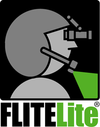FLITELite Light Color, Intensity & Night Vision
FLITELite offers aviators and operators a choice of colors:
- NVIS White (more information on NVIS White & Green)
- NVIS Green
- White - soft white
- Red
- NVIS Blue and Blue are available with special order
- Compatibility with NVGs or Night Vision Imaging Systems
- Brightness level needed - high or moderate
- Full Spectrum Light or Single Color
- Match cockpit or environmental lighting
- Conserve Central Vision or Peripheral Vision
- Is the enemy/counter-surveillance using an imaging system?

Compatibility with NVG or Night Vision Imaging Systems:
White is made up of blue and green phosphors, which creates a full spectrum effect while protecting central vision. Green will protect central night vision as well, however, greens will disappear on IFR charts for example. Red is will protect peripheral night vision, but not central vision as well as the soft white, NVIS White and green. Red's on charts will also not be visible with red light.
The eyes are comprised of Rods and Cones. We hear people talk about Rods being for night vision, and Cones for day vision, and while they both have their special attributes, it would be better to classify them in the aviation environment at Peripheral (Rods) and Central (Cones) vision. Both rods and cones have a day and night mode, and they both react to light at different rates, and to have sensitivity to different light frequencies.
Rods surround the periphery of the eye and are used for peripheral vision, and night vision. They do not see color, and do not detect motion. Rods only provide non-color vision at an acuity of 20/200. Rods are most susceptible to blue light. You never read, or scan your instruments with your Rods - or your peripheral vision - think about it. You are reading this article with your central vision - your cones.
Cones are used for color, central vision, with visual acuity of 20/20. The cones have a focal width of approximately 20 to 30 degrees. Cones are most susceptible to red light.
Cones are used when you read, day or night. During the day we read with our cones - during the night we need a light to read - obvious, but it shatters the red light myth in the aviation cockpit.
So the question is what is the best light that will provide your eyes, and brain with the best light for reading? The answer is a dim white light. Look inside any of the new jets, and you will find that the lighting is white. Military cockpits specify NVIS White. NVIS White appears to have a green tint, but it is a full spectrum light. Some older specifications use the NVIS Green specification for crew lighting as well. Both the NVIS colors we offer are Army Night Vision Lab approved. However, sometimes a nice bright light is needed, which makes and white such a nice choice to to the high brightness they are able to achieve.
FLITELite is set to a 25-35 degree field of view to maximize the physiology of the pilots eye. But to preserve night vision the intensity of the light is what matters. By using a full spectrum white light, the full spectrum light and low reflection reduces the amount of light needed. The 25-35 degree field is critical to keep the light out of our peripheral vision.
Under red light, magenta symbols disappear on charts, and during electrical failures, red markings on instruments and gauges are unreadable. Blue light will make Blue 100LL fuel disappear.
"I purchased a FLITELite at OshKosh also. I remembered being a little skeptical of the white LED's, but you assured me that they were right for the job. After flying with it, I have to agree with you. The FLITELite&® is just the right light for the cockpit. It was well worth the price I paid. My wife also likes not having to hold flashlights anymore as well. Darn good product." -Scott Anderson
More information on the Red Light Myth is available at: http://stlplaces.com/night_vision.html
"Just wanted to let you know of one of your successes. I purchased a light for my son at Oshkosh. He is a student pilot trying to finish up his rating before beginning his senior year in high school. He was on a dual night cross country last Monday. About thirty miles from home he had a complete power failure. Your light saved the day. His instructor has forgotten to pack a flashlight. My son had also taken my high-powered light. The instructor kept blinding him with the high beam on the flashlight, but the FLITElite® had just the right amount of light and saved the day! It was the best $50.00 I have ever spent. - Bruce Schrader
